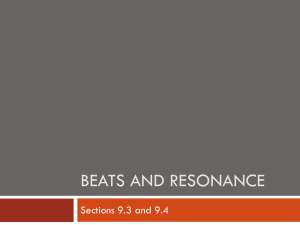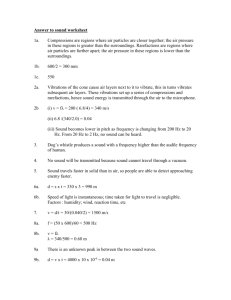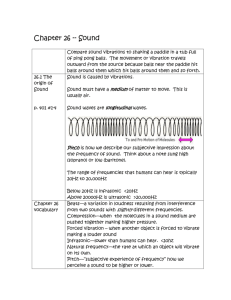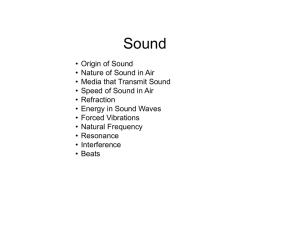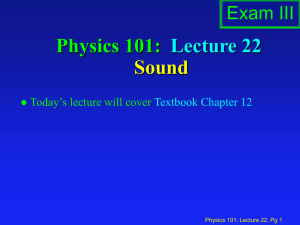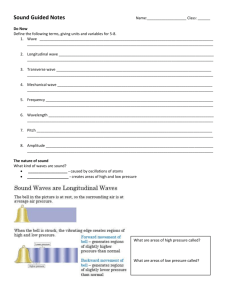Ch 26 Sound
advertisement
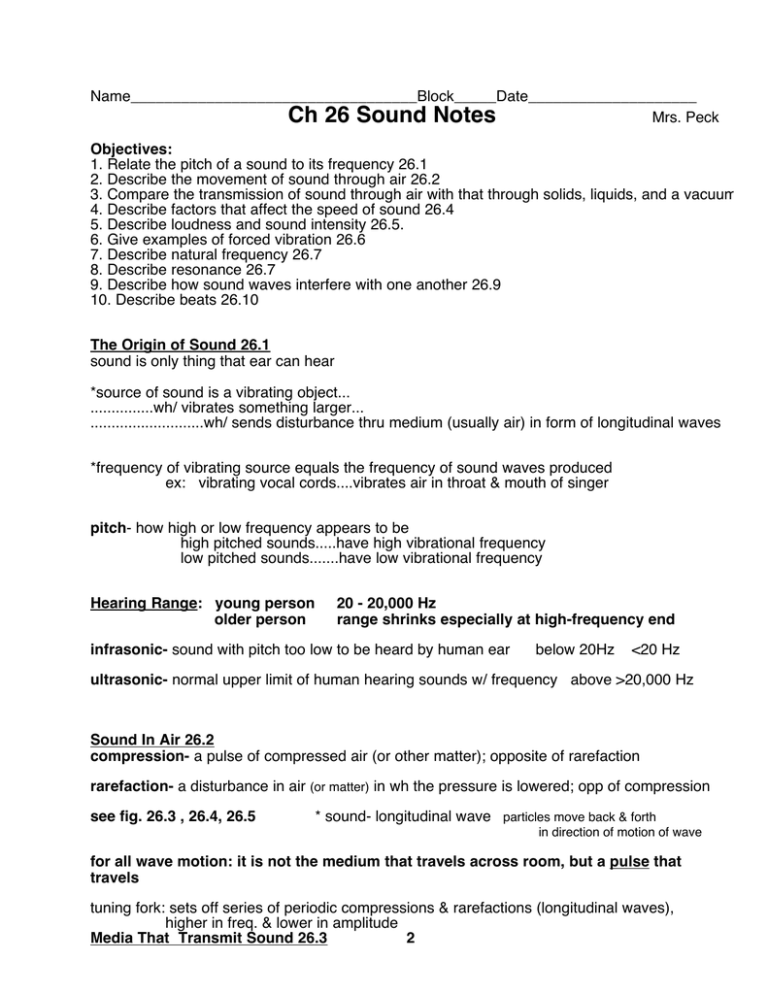
Name__________________________________Block_____Date____________________ Ch 26 Sound Notes Mrs. Peck Objectives: 1. Relate the pitch of a sound to its frequency 26.1 2. Describe the movement of sound through air 26.2 3. Compare the transmission of sound through air with that through solids, liquids, and a vacuum 4. Describe factors that affect the speed of sound 26.4 5. Describe loudness and sound intensity 26.5. 6. Give examples of forced vibration 26.6 7. Describe natural frequency 26.7 8. Describe resonance 26.7 9. Describe how sound waves interfere with one another 26.9 10. Describe beats 26.10 The Origin of Sound 26.1 sound is only thing that ear can hear *source of sound is a vibrating object... ...............wh/ vibrates something larger... ...........................wh/ sends disturbance thru medium (usually air) in form of longitudinal waves *frequency of vibrating source equals the frequency of sound waves produced ex: vibrating vocal cords....vibrates air in throat & mouth of singer pitch- how high or low frequency appears to be high pitched sounds.....have high vibrational frequency low pitched sounds.......have low vibrational frequency Hearing Range: young person older person 20 - 20,000 Hz range shrinks especially at high-frequency end infrasonic- sound with pitch too low to be heard by human ear below 20Hz <20 Hz ultrasonic- normal upper limit of human hearing sounds w/ frequency above >20,000 Hz Sound In Air 26.2 compression- a pulse of compressed air (or other matter); opposite of rarefaction rarefaction- a disturbance in air (or matter) in wh the pressure is lowered; opp of compression see fig. 26.3 , 26.4, 26.5 * sound- longitudinal wave particles move back & forth in direction of motion of wave for all wave motion: it is not the medium that travels across room, but a pulse that travels tuning fork: sets off series of periodic compressions & rarefactions (longitudinal waves), higher in freq. & lower in amplitude Media That Transmit Sound 26.3 2 sound needs a medium to travel thru....no media (vacuum) no sound fig. 26.6 nothing to compress and expand may still have vibrating obj. but no medium..no sound speed of sound differs in diff. media vsound faster in liquids than gases, and still faster in solids vsound solids > liquids > air Speed Of Sound 26.4 sound is slower than speed of light increase temperature....increase speed of sound speed of sound depends on 1. medium 2. temperature 3. elasticity speed of sound depends on substances elasticity: elasticity-ability of mat to ∆ shape in response to force & then resume initial shape once distorting force is removed elastic mat. the atoms are close tog. and respond quickly to each oth motions, transmitting E w/ little loss. Loudness 26.5 can measure intensity of sound but not loudness if increase amplitude of sound wave then increase intensity intensity measured in decibels dB loudness is a physiological sensation sensed in the brain loudness differs for diff. people Forced Vibration 26.6 fig. 26.8 forced vibration- vibration of obj made to vibrate by another vibrating obj that is nearby many musical instruments have sounding boards which encounter forced vibration...... therefore amplifying sound thru force vibration ex: vibration of guitar strings use wooden body as sounding board. wooden body encounters forced vibration from guitar strings therefore amplifying sound 3 Natural Frequency 26.7 fig. 26.9 natural frequency- freq at wh/ an elastic obj. once energized will vibrate, a minimum amt of E is needed to continue vibrating at that freq. object’s natural frequency depends on its elasticity and shape nat. freq is one at wh/ minimum energy is required to produce forced vibrations nat. freq requires least amt of energy to continue vibration Resonance 26.8 resonance- occurs when frequency of forced vibration matches object’s natural frequency therefore increases amplitude object must be elastic to resonate in order for something to resonant, it needs a force to pull it back to its starting position and enough energy to keep it vibrating fig 26.11 When a tuning fork is struck, it sets another tuning fork into vibration. They have the same natural frequency.......resonance occurs. The first fork is struck (not in image) & sends out a sound wave (longitudinal wave...a series of compressions & rarefactions) a. b. c. d. e. a compression meets the fork and gives it a tiny & momentary push the fork bends and then returns to initial position (returns to initial position) just at the time a rarefaction arrives the fork keeps moving back and overshoots in the opposite direction (bcs of rarefaction) just when it returns back to its initial position, the next compression arrives to repeat the cycle now the tuning fork bends farther because it is already moving Since the frequency of these pushes corresponds to the natural frequency of the fork, the pushes successively increase the amplitude of vibration. This is because the pushes occur at the right time and are repeatedly in the same direction as the instantaneous motion of the fork. eg. 1. when you adjust the tuner on a radio set, you are adjusting the natural frequency of the electronics in the set to match one of the many incoming signals...the set resonates to one station at a time, instead of playing all of the stations resonance occurs whenever successive impulses are applied to a vibrating object in rhythm with its natural frequency 2. the loose front end of a car that vibrates at only certain speeds 3. a crystal glass that shatters by a singer’s voice 4. when troops are marching on a bridge and the marching is the same frequency as the natural frequency of a bridge, steadily the bridge will sway back and forth increasing in amplitude Interference 26.9 4 sound waves (like any waves) can interfere with each other.......constructively or destructively fig. 26.13 Comparison of interference of transverse waves and longitudinal waves crests of transverse waves correspond with compressions of sound wave troughs of transverse waves correspond with rarefactions of sound wave ***interference effects intensity...”loudness” of sounds Fig 26.14 interference of sound waves constructive interference: increases loudness if sit equidistant between two speakers emitting simultaneous identical sound waves of constant frequency.. then the waves are in phase and have constructive interference (compressions and rarefactions arrive in phase or in step)...so sound is louder bcs the waves add up.....increase amplitude...increase in intensity or “loudness” destructive interference: decreases loudness if sit to side (not equidistant from speakers) so that the paths from the speakers differ by a half-wavelength....then the waves are out of phase & have destructive interference (compressions and rarefactions arrive out of phase or out of step....compression from one speaker arrives at same time as a rarefaction of other speaker......similar to a crest and trough at same time)...so sound is softer bcs the waves cancel each other...decrease amplitude....decrease intensity or “loudness” only decrease in loudness not complete silence for there is always some reflection of sound to fill in canceled spots in some gyms or auditoriums get some “dead zones” where get interference from sound from source and reflected waves off of walls....just move head to one side to get out of destructive interference pattern area COOL APPLICATION OF SOUND DESTRUCTIVE INTERFERENCE Antinoise technology: uses destructive interference to decrease loudness of noisy devices such as jackhammers, planes, engines ect. Antinoise devices have a microphone that captures incoming sound...creates a mirror image (that is out of phase with incoming sound)...then this mirror image signal is sent to headphones that are worn by operator. The compressions of actual sound are canceled by the rarefactions of mirror image sound fed into headphones.....decreasing loudness of machine’s sound.....cool Beats 26.10 5 interference of 2 slightly different frequencies causes beats beats: fluctuation in loudness of combined sounds....loud...soft....loud....soft....loud... beats: periodic variation in loudness of sound beats- a throbbing variation in the loudness of sound caused by interference when two tones of slightly different frequencies are sounded together fig. 26.16 creating of beats the 2 sound waves have slightly different frequencies -periodically the compressions of both will be in phase (increase in loudness) -periodically the rarefaction of one will interfere with the compression of the other..out of phase....so (decrease in loudness fig. 26.17 sine curves from an oscilloscope illustrating beats first 2 sine curves are the 2 sound waves of slightly different frequencies 10Hz & 12Hz last sine curve is the composite sine curve of the 2 waves above superimposed.... which illustrates beats being formed COOL APPLICATION OF BEATS: musicians use beats to tune instruments.....use a tuning fork or oboe to produce a sound of a certain frequency...then instrument plays that same frequency too. If the instrument is slightly out of tune (slightly different frequency) you will hear beats produced. Keep tuning instrument until hear single tone & no beats. determining the beat frequency & tone heard during interference of 2 slightly different frequencies to determine the beat frequency: subtract the smaller frequency from the larger frequency....this is the frequency of beats that will be heard (number of beats per second) eg. 262 Hz and 264 Hz 264 Hz - 262 Hz = 2 Hz (2 beats per sec) to determine the tone of the beats heard: the tone will be the frequency half way between the 2 frequencies find the avg. frequency of the 2 frequencies eg. 262Hz and 266 Hz (262 Hz + 266 Hz) divided by 2 = 264Hz beats occur with any kind of wave and are a practical way to compare frequencies

